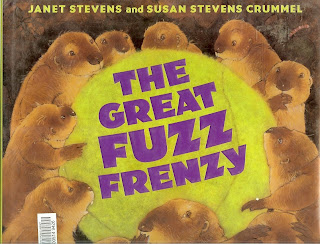Bibliographic Citation
Richardson, J., & Parnell, P. (2005). And Tango makes three. New York: Simon & Schuster Books for Young Readers.
Summary
This is based on a true story about two male penguins at the Central Park Zoo in New York City. They became a couple except they could not have a baby penguin. One day their caretaker needed to care for an extra penguin egg. So he decided to give the egg to Silo and Roy to care for. The egg hatched and the baby was named Tango. So Tango was raised by the two male penguins.
Impressions
This was a controversial book when it was published. It was on the Top Ten Most Censored Books. I am not offended by this book and I would not be afraid to share this book with second grade and up. I admire the caretaker of the zoo for trying to help Roy and Silo know what it felt like to be a parent penguin. Sometimes animals are different from their other same species. I feel like some people will look at this as a "gay" type book but I see it as trying to help the parental needs of those two penguins.
Suggestions for use in a library setting
1. Reading to a class doing studies of penguins or artic animals.
2. Unusual families study.
Reviews
Tango has two daddies in this heartwarming tale,
inspired by actual events in New York's Central Park Zoo. Two male penguins, Roy
and Silo, "did everything together. They bowed to each other.… They sang to each
other. And swam together. Wherever Roy went, Silo went too. … Their keeper…
thought to himself, 'They must be in love.'" Cole's (The Sissy Duckling)
endearing watercolors follow the twosome as they frolic affectionately in
several vignettes and then try tirelessly to start a family--first they build a
stone nest and then they comically attempt to hatch a rock. Their expressive
eyes capture a range of moods within uncluttered, pastel-hued scenes dominated
by pale blue. When the keeper discovers an egg that needs tending, he gives it
to Roy and Silo, who hatch and raise the female. The keeper says, "We'll call
her Tango,… because it takes two to make a Tango." Older readers will most
appreciate the humor inherent in her name plus the larger theme of tolerance at
work in this touching tale. Richardson and Parnell, making their children's book
debut, ease into the theme from the start, mentioning that "families of all
kinds" visit the zoo. This tender story can also serve as a gentle jumping-off
point for discussions about same-sex partnerships in human society. Ages 4-8.
(June)
And Tango makes three.
(2005). Publishers Weekly, 252(20), 61-62.
PreS-Gr 3-- When two male penguins at
the Central Park Zoo form a special bond, build a nest, and attempt to hatch a
rock, a zookeeper provides them with an egg in need of care, and the devoted
fathers happily welcome a fuzzy baby into their lives. Based on a true story,
this delightful tale about a unique and loving family is enhanced with endearing
watercolor paintings. Book
And Tango makes three.
(2006). School Library Journal, 52(3), 9.
PreS-Gr 3-- This tale based on a true
story about a charming penguin family living in New York City's Central Park Zoo
will capture the hearts of penguin lovers everywhere. Roy and Silo, two male
penguins, are "a little bit different." They cuddle and share a nest like the
other penguin couples, and when all the others start hatching eggs, they want to
be parents, too. Determined and hopeful, they bring an egg-shaped rock back to
their nest and proceed to start caring for it. They have little luck, until a
watchful zookeeper decides they deserve a chance at having their own family and
gives them an egg in need of nurturing. The dedicated and enthusiastic fathers
do a great job of hatching their funny and adorable daughter, and the three can
still be seen at the zoo today. Done in soft watercolors, the illustrations set
the tone for this uplifting story, and readers will find it hard to resist the
penguins' comical expressions. The well-designed pages perfectly marry words and
pictures, allowing readers to savor each illustration. An author's note provides
more information about Roy, Silo, Tango, and other chinstrap penguins. This
joyful story about the meaning of family is a must for any library.
Roach, J., Jones, T. E.,
Toth, L., Charnizon, M., Grabarek, D., & Raben, D. (2005). And Tango makes
three. School Library Journal, 51(7), 81.
In this true, straightforwardly (so to speak) delivered
tale, two male chinstrap penguins at New York City's Central Park Zoo bond,
build a nest and--thanks to a helping hand from an observant zookeeper--hatch
and raise a penguin chick. Seeing that the penguins dubbed Roy and Silo "did
everything together. They bowed to each other. And walked together. They sang to
each other. And swam together," their keeper, Mr. Gramzay, thinks, "They must be
in love." And so, when Roy and Silo copy the other penguin couples and build a
nest of stones, it's Gramzay who brings a neighboring couple's second egg for
them to tend, then names the resulting hatchling "Tango." Cole gives the proud
parents and their surrogate offspring small smiles, but otherwise depicts
figures and setting with tidy, appealing accuracy. Unlike Harvey Fierstein's
groundbreaking The Sissy Duckling (2002), also illustrated by Cole, this doesn't
carry its agenda on its shoulder; readers may find its theme of acceptance even
more convincing for being delivered in such a matter of fact, non-preachy way.
(afterword) (Picture book/nonfiction. 5-9)
And Tango makes three.
(2005). Kirkus Reviews, 73(11), 642.













